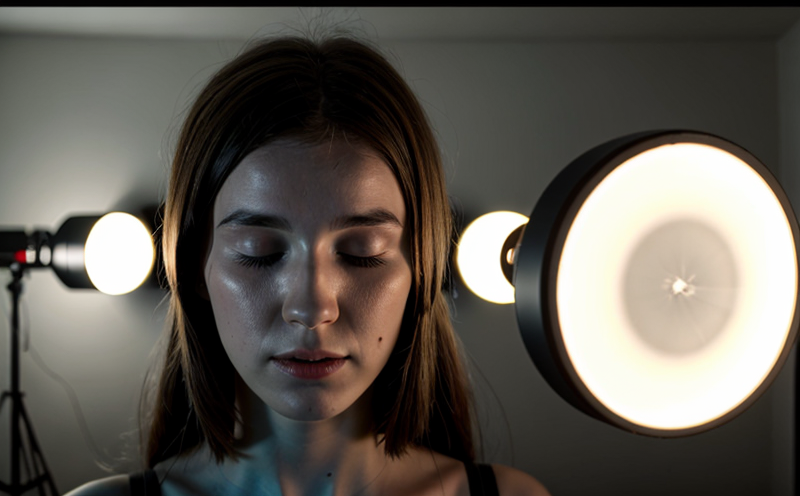IEEE 1789 Flicker Risk Assessment Testing of LED Lighting Products
The IEEE Standard P1789-2015, titled "Recommended Practice for Assessing Flicker in LED Lighting Products," is a critical tool for ensuring the safety and comfort of users exposed to LED lighting products. This standard provides guidelines on how to assess flicker, which can be caused by variations in light output due to non-linear control circuits or harmonics in the power supply.
The primary focus of this testing is to identify any potential hazards associated with flicker that might cause discomfort, visual stress, or even adverse health effects for individuals who are particularly sensitive to such stimuli. Flicker can be categorized into two main types: photic sensitivity, which affects people with epilepsy and photosensitive seizure disorders; and visual discomfort, which impacts the general public.
According to the standard, flicker is quantified in terms of CIE flicker index (FI) or Flicker Probability (FP). The CIE FI ranges from 0 to 1, where values below 0.2 are generally considered safe for sensitive users. FP measures the likelihood of causing visual discomfort based on individual sensitivity levels.
The testing process involves subjecting LED lighting products to a series of controlled conditions that simulate real-world usage scenarios. This includes varying ambient light levels, power supply parameters, and frequency ranges. Specimen preparation typically entails ensuring the product is in its final form as it would be sold to consumers. The apparatus used for this test includes specialized measurement equipment capable of capturing light output variations at a high sampling rate.
During testing, the instrument continuously monitors the LED's light output over time and calculates the flicker index or probability based on predefined thresholds. If the calculated value exceeds specified limits, it indicates that the product may pose a risk to certain user groups. Reporting involves providing detailed documentation of test procedures, results, and any non-compliance findings.
Understanding flicker is crucial for manufacturers because even low levels can lead to significant issues. For instance, prolonged exposure to high flicker intensity has been linked to increased eye strain, headaches, and reduced productivity in work environments. In severe cases, it could exacerbate existing health conditions like epilepsy.
The importance of this testing cannot be overstated, especially considering the rapid growth of LED technology across various sectors such as commercial buildings, residential homes, and public spaces. Compliance with IEEE 1789 ensures not only product safety but also enhances consumer satisfaction by delivering a more pleasant lighting experience.
Moreover, adherence to this standard can help manufacturers avoid potential legal risks and negative publicity associated with product recalls or lawsuits due to flicker-related incidents. By demonstrating commitment to user well-being through rigorous testing practices, companies can build trust and maintain their brand reputation in the competitive market.
Applied Standards
The IEEE 1789-2015 standard is widely recognized for its comprehensive approach to flicker risk assessment. It aligns closely with other international standards such as ISO/IEC 36241:2012, which provides additional guidance on measuring photic sensitivity, and EN 1794-1:2018, focusing on lighting for indoor use. These standards complement each other by covering different aspects of visual comfort and safety.
In addition to these official documents, many jurisdictions have adopted or are in the process of adopting IEEE P1789 as a local regulation. This makes it an essential requirement for manufacturers seeking global market access. For example, several European countries include compliance with this standard in their electrical equipment directives.
Benefits
Compliance with IEEE 1789 offers numerous advantages beyond mere regulatory adherence. It enables organizations to:
- Enhance Product Safety: By identifying and mitigating flicker risks early in the design phase, companies can prevent harmful effects on sensitive users.
- Promote User Comfort: Consumers experience a more enjoyable and less stressful lighting environment, leading to higher satisfaction levels.
- Avoid Legal Issues: Reduces the risk of product liability lawsuits by ensuring products meet stringent safety standards.
- Gain Competitive Edge: Demonstrating commitment to quality and user well-being can set a company apart in competitive markets.
- Foster Brand Reputation: Positive feedback from satisfied customers contributes to building a strong brand identity.
In summary, implementing IEEE 1789 not only meets legal requirements but also enhances overall product quality and customer experience.
Eurolab Advantages
At Eurolab, we pride ourselves on delivering world-class testing services tailored specifically to meet the needs of our clients. Here’s why choosing us for your IEEE 1789 compliance is the right choice:
- State-of-the-Art Facilities: Our laboratories are equipped with advanced measuring instruments capable of accurately capturing even minute fluctuations in light output.
- Experienced Technicians: Our team comprises highly skilled professionals who stay updated on the latest developments and best practices in flicker testing.
- Comprehensive Reporting: We provide detailed reports that go beyond mere compliance verification, offering valuable insights into product performance and potential improvements.
- Cost-Effective Solutions: By streamlining processes and leveraging our extensive experience, we ensure efficient and cost-effective testing without compromising on quality.
- Timely Delivery: We understand the importance of meeting deadlines. Our streamlined procedures allow us to deliver results quickly while maintaining high standards.
- Ongoing Support: Post-testing support is available for any questions or further analysis needs, ensuring a seamless transition from testing to implementation.
We are dedicated to helping our clients achieve excellence in their product development and compliance efforts. Let us assist you on your journey towards meeting IEEE 1789 requirements.





